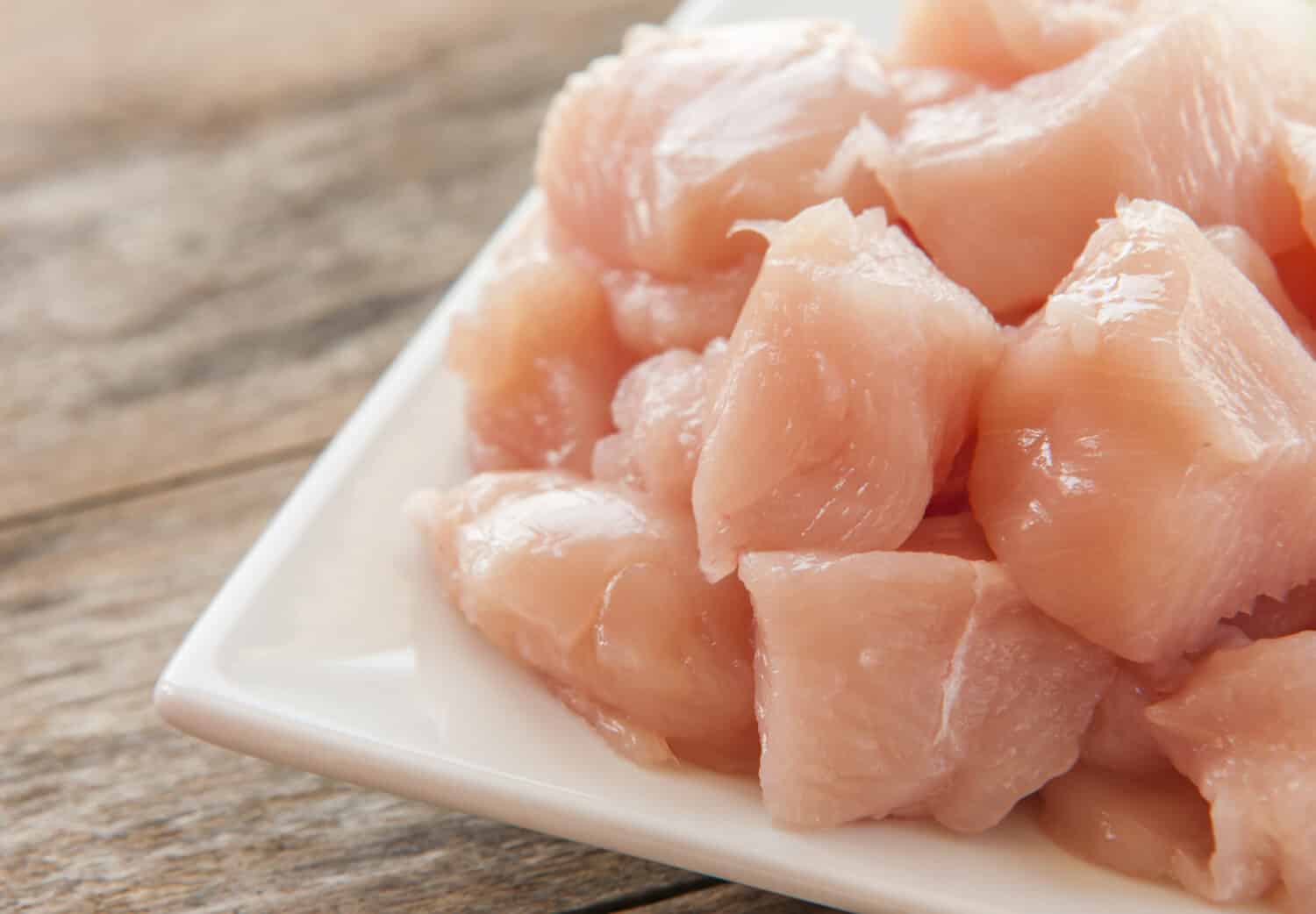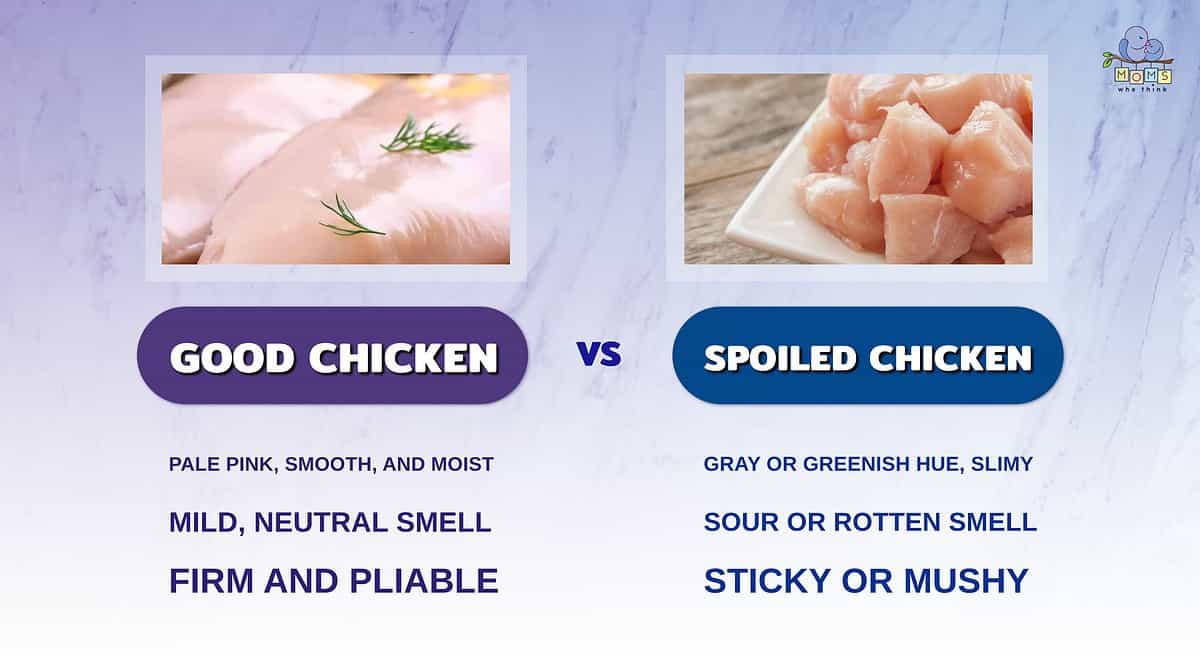As parents, we strive to provide the best for our families. This is especially true in the kitchen as we work to prepare family meals. We want to be confident in our choices and one food item that can sometimes leave us scratching our heads and questioning our family's safety is raw chicken. Raw chicken is a staple in many households, but knowing how to identify the signs of good and bad chicken breast is essential to prevent foodborne illnesses and ensure the well-being of our loved ones.
In general, chicken that is still fresh and raw is pink and meaty, while chicken that has spoiled is discolored and has a dull, grey hue. There are other differences between fresh and raw chicken breast as well.
- The must-have convenient reference guide for every home cook!
- Includes more than 8,000 substitutions for ingredients, cookware, and techniques.
- Save time and money on by avoiding trips to grab that "missing" ingredient you don't really need.
In this blog post, we will delve into the important characteristics that set apart good and bad raw chicken breasts. From appearance and smell to texture and proper handling, we'll explore the key factors to consider when assessing the quality of chicken before it hits the pan. Let's dive in!
Good vs. Bad Raw Chicken Breast: What are the Differences?

©iStock.com/voltan1
As mentioned, fresh raw chicken is pink in color while chicken breast that has gone bad will look dull and greyish. Good and bad raw chicken will also smell differently and have different textures that set them apart. Let's take a closer look at the differences between fresh and spoiled raw chicken breasts so you can feel confident with the meat you use in your next meal.
Appearance
Fresh raw chicken breast should have a pale pink color with a smooth and moist surface. It should be firm to the touch. Chicken that has gone bad may have a grayish or greenish hue. It may appear slimy or discolored. If the chicken looks or feels slimy, that's a strong indication that it's spoiled.
It's also important to note that if you begin cooking chicken that has already gone bad, it may not change color like fresh chicken does. Fresh chicken breast will often change from pink to white as it cooks while spoiled chicken will remain a greyish hue.
Additionally, if you notice any visible signs of spoilage such as mold growth, you'll definitely need to toss that chicken in the trash can. Unlike cheese where you can remove the mold spot and consume the rest, chicken can make you ill if moldy and consumed.
Smell
Fresh raw chicken has a mild, neutral smell or a slightly sweet aroma. While not all spoiled chicken has a textbook smell, use your best judgment. If the chicken has a strong, unpleasant odor or emits a sour or rotten smell, it's best to discard it.
Some people also describe rotten chicken as having an ammonia-like smell. If you find this is the case for the chicken you're about to use, be sure to toss it and cook your meal with fresher chicken.
Texture
The texture of fresh raw chicken should be firm and pliable. It should bounce back when pressed lightly and it should be smooth and shiny on the outside. If the chicken feels slimy, sticky, or has a mushy texture, it's likely spoiled and should not be consumed.
Additionally, spoiled raw chicken breast can sometimes have a film on top or leave a slimy residue on your hands after touching it, indicating it's gone bad.
Expiration Date
Always check the expiration date on the packaging of the chicken. If the chicken is within the expiration date and meets the other criteria mentioned above, it is likely safe to consume. If the chicken is past its expiration date, it should be discarded, regardless of its appearance or smell. Also, if it hasn't passed its expiration date but doesn't meet the criteria above, it's best to also discard it. In the case of raw chicken, it's always better to err on the side of caution and discard anything that raises concerns.
Depending on where you shop and what you purchase, you may also notice that there are two dates on your package of chicken. One is a “packaging date” and one is a “sell by” date. The first is self-explanatory – it's the date on which the manufacturer packaged the item. The sell-by date, however, is the one you should pay attention to. Storing chicken in the fridge past this date likely means it has already spoiled.
Appropriate Storage and Handling of Raw Chicken Breast

©Adriana Marteva/Shutterstock.com
Proper storage and handling practices are crucial for maintaining the quality of raw chicken. Chicken can spoil quickly if not stored or handled properly.
So how long do you have to use your chicken before it goes bad? According to the USDA guidelines, fresh poultry should be used or frozen within 1 to 2 days of purchasing. Also, be sure your refrigerator is at temperatures below 40°F (4°C). This may seem like a short time frame, but it's best not to risk ingesting bacteria or a food-born illness from spoiled chicken. Additionally, if you don't get a chance to use your chicken within the timeframe recommended, the USDA reports that fresh poultry can be kept in the freezer anywhere from nine months to a full year.
- The must-have convenient reference guide for every home cook!
- Includes more than 8,000 substitutions for ingredients, cookware, and techniques.
- Save time and money on by avoiding trips to grab that "missing" ingredient you don't really need.
It's also important to note that leaving raw chicken at room temperature for too long can facilitate bacterial growth, leading to foodborne illnesses. The USDA also recommends focusing on the “2-hour rule.” This rule suggests not leaving food out at room temperature (40° to 140°, also known as the “danger zone”) for more than 2 hours as it can lead to an increase of bacteria.
In short, keep your chicken refrigerated, use or freeze it after 1-2 days of purchasing, and use or toss it after nine months to one year in the freezer. Keeping these basic storage rules will ensure your chicken remains fresh!
Proper Preparation of Raw Chicken Breast
It is important to note that even if the chicken appears and smells fine, it's still necessary to cook it thoroughly to kill any potential bacteria. Salmonella or Campylobacter may still be present.
The CDC released a few guidelines for safely handling raw chicken, including:
- Be sure to wash your hands thoroughly for at least 20 seconds before and after handling raw chicken.
- There is no need to rinse or wash the chicken before cooking. Doing so can spread germs and cause potential cross-contamination with other foods.
- Use a separate cutting board when cutting or preparing raw chicken.
- Do not let the juices of raw chicken spread to other foods.
- Be sure to use separate utensils and plates when dealing with both raw and cooked chicken.
- Cook your chicken to a safe internal temperature of at least 165° F.
Safely cooking raw chicken can be tricky. It's best to follow these guidelines to keep everyone in your household safe and healthy.
Chicken Breast Recipes
Print
Mozzarella Chicken
Ingredients
- 4 whole chicken breasts (boneless)
- 3 eggs
- 1/2 cup Italian breadcrumbs
- 1/4 cup grated Parmesan cheese
- 1 stick butter (add more as needed, butter reduces with cooking)
- 1/2 lb. Mozzarella cheese
- 1/2 lb. fresh mushrooms (optional)
Instructions
- Slice chicken breasts into serving size pieces. Place chicken in slightly beaten egg for 1 hour and refrigerate.
- If using mushrooms, sauté and set aside.
- Combine the breadcrumbs and Parmesan cheese on a shallow plate. Roll chicken pieces in breadcrumb mixture and fry in butter until brown (about 10 minutes). Add additional butter as needed for frying.
- Place chicken in 9 x 13 dish and place mushrooms on top (if using).
- Bake for 10 to 15 minutes in a preheated 325 degree oven.
- Remove from oven, place Mozzarella cheese cheese on top.
- Place chicken back in oven until cheese melts.
Final Thoughts

- Fresh chicken should be pale pink, smooth, and moist. If your chicken has a gray or greenish hue, or if it feels or looks slimy, it's definitely gone bad and should immediately be discarded.
- Spoiled chicken will have a foul odor; this is often one of the most tell-tale signs that chicken has gone bad. Fresh chicken should have a mild, neutral, and possibly sweet smell.
- Fresh chicken will be firm and pliable; it should bounce back when pressed down upon. Bad chicken will be sticky or mushy, and may have a film coating it.
Remember to trust your senses when it comes to identifying if your chicken is still fresh or if it has gone bad. Using your sense of smell and sight can help you determine if the chicken you're about to use is safe to eat.
In our quest to create delicious meals for our families, understanding the differences between good and bad raw chicken breast is critical. By paying attention to key characteristics such as appearance, smell, texture, and proper handling, we can confidently navigate the realm of raw chicken and ensure the health and well-being of our loved ones.
The image featured at the top of this post is ©aleksandr talancev/Shutterstock.com.


